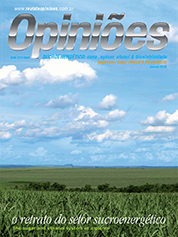Antoninho Marmo Trevisan
President of Trevisan Escola de Negócios
Op-AA-25
End of the ethanol bubble
About three years ago, the sugar and ethanol industry, viewed from its bio-energy perspective, enjoyed an excellent phase, drawing up economic strategies, bringing about heated debates and political actions in all government areas. Now times have changed. The assessment is that the activity is back on the ground after its long period of an imaginary blue sky ride.
The world turned to the production of ethanol as the planet’s salvation in the medium term, apparently willing to debate the need to work with cleaner energy to slow down the uncontrollable destruction of the environment. For us, this is not exactly a novelty, albeit for other reasons. Brazil’s ethanol program – called Proálcool – was created in response to the oil crisis of the seventies.
The initial concern was to find a replacement for fossil fuel, whose price was highly unfavorable for the country, in the context of the hostile handling of the product by oil exploiting nations. Ever since, and with no inhibition, Brazil developed the ethanol energy matrix. This period stood out for the intensive research conducted and the controversy about the initiative’s practical result, given that nobody believed in it and certainly did not bet that some day it would carry relevant weight in the world economy.
With ethanol destined for the vehicle fleet gaining international status, the price of land for sugarcane plantations was highly inflated, mills took up center stage positions in the Brazilian economic system and the flow of foreign capital inundated the country. On the other hand, policies (some opportunistic) were discussed and created to regulate the industry in times of expansion.
Social groups complained about labor conditions of sugarcane plantation workers, which in fact were and still are reason for concern. Thus, given the ingredients involved, the subject matter became recurrent and irresistible in the public opinion. Speculation was in everyone’s mouth. All possible angles of the subject matter were talked about.
The sugar and ethanol industry’s bubble inflated until it burst a few months later – the international financial crisis that began in September 2008 helped to further enhance the impact. At the same time, the matter became uninteresting for opinion builders, but the debris is still around. Ethanol continues to play an important role in the ranking of fuels for the future, but it is far from exercising the influence and importance, and from having the geopolitical standing, that oil imposes on the world.
One need not be a specialist to conclude that a considerable number of the conflicts that nowadays occur around the world involve the control of oil, not to mention that fossil fuel will no doubt, and for decades to come, play the lead role in the energy matrix of the major countries. It is up to our ethanol to show the world its efficiency and capacity as a new fuel for humanity, with companies more focused on their objectives, aligned with the new market reality.
It is also necessary to prove its social and environmental sustainability, otherwise its strong appeal as a clean alternative energy with respect to high carbon dioxide emissions caused by gasoline and diesel oil consumption in automobiles will not hold. When the issue is to show its sustainability characteristic, this relates mainly to how sugarcane plantation areas are defined, labor relations, the harvesting model and the benefits for the community living in the vicinity of the production unit.
It is true that the sugar and ethanol industry made progress in recent decades, involving intensive participation of private agents and inevitable interventions by the State. It developed in terms of productivity, but it is still subject to shortcomings in storage infrastructure and transportation – actually, a problem for all economic sectors, in addition to the already mentioned issue of more consistent commitments to practicing social and environmental responsibility in any given production center.
Foreign capital, which has taken charge of a considerable share of the market – both at the time it boomed and after the bubble burst – paying modest amounts for mills on the verge of bankruptcy -, is expected to boost internationalization of everything produced in this industry. Access by these foreign groups to the local market will provide the system new momentum, supported by a family business model with a low degree of professionalism.
However, this will not do away with the existing losses in the sugar and ethanol production chain, mainly in the industry’s fully Brazilian-owned companies. The false notion of immediate growth without taking into consideration the storms – from those caused by the economic bloating of the industry through to adverse climate conditions – caused uncertainties that require taking care of because the outlook for the industry is quite interesting. The favorable accounting is actually almost the same that existed three years ago, but at the time, the option made was for speculation and euphoria with respect to sugarcane. This is now over, and the industry is getting ready for a new time, anchored in reality.




